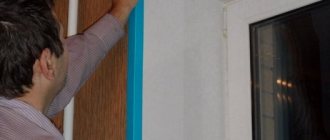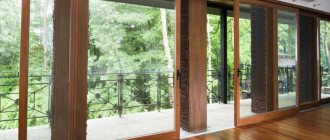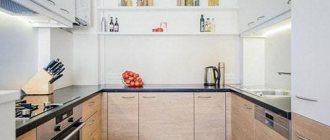Panoramic glazing is very often used in modern buildings and cottages. This is an indicator of eliteness, unusual construction style and the “zest” of the interior. Which windows are better to choose, is the beauty and prestige of floor-to-ceiling windows worth the significant costs of their installation and maintenance, and how to solve the problems associated with panoramic glazing? It is necessary to understand everything in order.
Floor-to-ceiling windows are large-area windows that are placed across the entire wall from ceiling to floor. They are designed to create a unique interior and provide the most complete natural lighting of an apartment or house.
Classification of panoramic windows
- Glazing without the use of frame structures (frameless) does not involve the use of guides and frames.
A single plate is installed across the entire wall and creates the illusion of invisibility and weightlessness. This type of window is one of the most expensive, but apart from external qualities, it does not have any great advantages. Frameless windows do not protect against cold and noise; they cannot be opened and ventilated. Their installation is often driven by a design decision to fit into a specific concept; - Frame glazing - involves the use of a frame in the window structure, which can be made of various materials: aluminum, plastic, fiberglass, metal-plastic, wood.
Floor-to-ceiling windows have a significant number of advantages
- Visual increase in space. Transparent walls create the effect of a large room, even if it has a small area.
- Natural light with large windows increases significantly.
- Floor-to-ceiling windows give the building and interior a special aesthetic appearance and appeal.
- The beautiful view that opens behind the huge windows will delight and lift your spirits.
However, before choosing floor-to-ceiling windows for your premises, you need to think through all the problems associated with such glazing and possible ways to solve them.
How to calculate square meters of a wall with a door
Similar actions must be performed when you need to calculate the square meters of a wall with a door. If the door, from a mathematical point of view, is a simple rectangle, then we calculate its area using the usual formula A X B. That is, you need to measure the height and length, then multiply the numbers and get the size of the door.
Next, we subtract the size of the door from the area of the wall and get the square footage for which it will be necessary to buy finishing materials. If the previous owner of the apartment made a door with an arch, then there is no way to do without calculating the size of the circle.
Problems of panoramic windows and solutions to them
- Significant heat loss due to huge glass structures. To avoid this problem, you can install energy-saving windows.
They have a special layer, which is a metal coating. It is composed of metal oxides and allows glasses to reflect infrared rays without much light resistance. Such double-glazed windows reflect heat from the radiators, as a result of which the room heats up faster;
In addition, double-glazed windows are insulated in the following ways:
- Increase the number of cameras. As a rule, double-glazed windows are used. There are also three-chamber windows, but their cost is much higher, and heat loss is not significantly reduced;
- The space inside the frames is filled with a special inert gas, most often argon, which helps retain heat;
- A thermal curtain is used to additionally prevent heat exchange between the window space and the room;
- They install shutters - shutters consisting of artificial material and fixed to the vertical profiles of the window frame. They prevent the passage of cold air and are removable.
- The problem of overheating due to frequent penetration of sunlight. It will help to eliminate it:
- Use of energy-saving double-glazed windows. Mirror coating of glass reflects the sun's rays and does not allow them to heat the room;
- Window tinting is also capable of reflecting some ultraviolet rays;
- The use of shutters provides protection from overheating during the warm season.
- The problem of insufficient sound insulation. To eliminate it, you should choose two-chamber windows with chambers of different thicknesses.
However, they are heavy, and excess load can lead to rapid wear of the fittings. Therefore, acoustic films are used to provide additional noise protection. They consist of three layers: the outer ones are made of ordinary film, and in the middle there is a special sound-absorbing layer. Such films have not yet become widespread in Russia, but they are very popular abroad. - The problem of icing and fogging of windows. To solve this, heat sources are installed next to the windows and thus create a thermal curtain.
A warm baseboard can solve this problem.
And to prevent the appearance of condensation, provide constant ventilation and ventilation. - Fading problem. A large amount of light and sunlight lead to fading and fading of objects located both indoors and outside the house.
This applies to a greater extent to energy-saving windows. Their glass reflects ultraviolet rays, resulting in double solar exposure. For this reason, the area near the window, for example, siding, burns out, and plants planted under the windows can dry out and die, the stone covering heats up to very high temperatures. Therefore, you should not plant plants in the area where rays reflect from windows, or place any objects there. The material around the window space must be resistant to sunlight. - The problem of maintaining and cleaning floor-to-ceiling windows. Huge windows need to be washed periodically and cleared of stains. If such windows are not on the ground floor, then special workers have to be hired to clean the glass from the outside, and this service is expensive. The manufacturer's application of a photocatalytic composition to the glass will help solve the problem. It gives windows the property of self-cleaning. When exposed to the sun, dirt decomposes directly on the glass and is washed away by the next rain or watering from a hose.
- The problem is a wide view of the premises from the street and low privacy. To prevent it, you can stick tinted film or mirror coating on the windows.
- Safety problem when using floor-to-ceiling windows. In the case where the wall consists almost entirely of glass, the strength of the double-glazed window and its reliability must be taken into account. To strengthen panoramic windows you can use:
- Windows made of tempered glass - in this case, high temperature exposure and treatment with a special chemical composition are used in the production of glass. As a result, the strength of double-glazed windows increases approximately 5 times;
- Using triplex material as glass.
It consists of transparent layers of silicate glass, which are held together by a polymer. This material is highly durable and ensures safety. Even under strong mechanical stress, it remains solid and cannot shatter into fragments. Triplex also has additional sound and heat insulation qualities.
Calculate the area of window and door openings
Before calculating the area of the walls, it is necessary to measure the window and door openings in order to subtract this space and find out the quadrature of only the surface being processed. Readings are taken only along the slopes of openings.
It is important to accurately measure window and door openings
For example, we have a square window whose dimensions are 1.50 in length and 1.60 in width. We carry out similar calculations: 1.50x1.60 = 2.40 m 2. If there are several windows in the room, then each of them is measured separately and the data obtained is added to one sum. A similar operation is carried out with doorways, where readings are taken not along the door itself, but precisely along the opening in the wall.
For example, as a result of measurements, we found out that the window area is 2.40 square meters, and the door, for example, 5.60. Next, we add the dimensions of the openings into one sum and subtract it from the total area of the room 2.40 + 5.60 = 8, 46-8 = 38. As a result, we have an opening area of 8 m2, subtract it from the total square footage of the room and get 38 m2 of treated surface.
Video on how to calculate wall area:
Dimensions of panoramic windows
The area of window structures is determined by state standards and also depends on the strength of the material from which the windows are made.
Basic requirements for the size of panoramic windows:
- The area of the window structure should be no more than 6 sq.m.
- A large window block must have partitions; the parameters of individual parts should not exceed 2.5 sq.m.
- Reinforced window sashes with a thickness of 1.5 mm can have maximum dimensions of 0.9 m in width and 2.1 m in height. When the width increases to 1.2 m, the height decreases to 1.5 m.
- The panoramic window sash must have a weight not exceeding 75 kg.
- The radius of the arched window cannot be made less than 0.3 m.
By observing the above requirements, it will be possible to avoid problems with breakage of window structures and fittings and ensure the safety of using floor-to-ceiling windows.
Floor-to-ceiling windows require the installation of a special heating system. Conventional radiators that are installed along the walls are not suitable for this type of glazing.
How experts calculate glazing area
From the point of view of designers, windows are the most vulnerable points in the building envelope. Through them there is intense energy exchange between the room and the environment.
Calculation of window area is carried out according to the methods given in SNiP (“Building Norms and Rules”). They provide illumination standards for various types of premises, corresponding coefficients and formulas.
In a simplified way, the area of light openings can be calculated based on the recommended ratios between the areas of windows and floors. These data were not taken out of thin air, but were obtained on the basis of many years of data analysis in various regions of the world.
The relevant information was summarized and compiled into easy-to-use tables.
For example, for civil buildings in the climatic conditions of the middle zone at an altitude not higher than 800 m above sea level, with slight shading by nearby buildings, the ratio of glazing area to floor area will be as follows:
- living rooms - 1/8–1/6;
- kitchens and corridors - 1/10–1/8;
- staircases - 1/14–1/10;
- classes and audiences - 1/4–1/3;
- playing and dining rooms in kindergartens - 1/4–1/3;
- hotel rooms - 1/8–1/6;
- library reading rooms - 1/6–1/5;
- offices and laboratories of the research institute - 1/7–1/5;
- administrative premises - 1/10–1/6;
- sports gymnasiums - 1/6–1/5;
- gyms - 1/5–1/4;
- medical offices - 1/7–1/5;
- hospital wards - 1/7–1/6;
- restaurant halls - 1/8–1/6;
- trading floors of stores - 1/8–1/6.
Together with panoramic windows, the following methods of heating the room are used:
- Convector heating – the convector is mounted outside or inside the floor along the panoramic window with an indentation of 8 to 20 cm so that the curtains do not interfere with the flow of warm air. Convectors circulate warm and cold air, due to which the room quickly warms up.
- Warm floors have several varieties:
- Water - pipes are installed in the floor, the water in which can be heated either by electricity or using a gas boiler. Installation of such floors is expensive, but subsequently they will be a fairly economical form of heating;
- Cable floors involve laying cables or special mats into which heating wires are built-in. This method of heating rooms is very expensive due to high electricity consumption. It is advisable to use cable floors in certain areas of a living space, for example, directly in the area of panoramic windows to create a thermal curtain. Installing a heating cable throughout an entire apartment or house is unprofitable;
- The most convenient and economical type of heated floors are film or infrared floors.
An infrared film heated floor has been installed.
A thin polyester film contains strips of carbon paste sealed into it. They are supplied with alternating voltage via copper conductors. The film heats up quickly and radiates heat. Film heating can be installed under any type of floor covering. In addition, it can be installed in the wall and ceiling. - Warm skirting boards – a heat exchanger consisting of copper tubes with lamellas is mounted under the baseboard.
It allows you to create a thermal curtain near floor-to-ceiling windows, warming the floors themselves and adjacent walls. Warm baseboards prevent the formation of ice and condensation on windows and protect walls from mold. - To heat rooms with panoramic windows, you can use additional heating devices.
These include various radiators, infrared heating devices, fireplaces. Their constant use incurs many costs, so it is advisable to use them only in special cases.
Interior design when installing panoramic windows
Interior design with floor-to-ceiling windows requires a certain approach. If the apartment is located in the city center, then it is better to make the interior in a modern style with a lively design filled with contrasts.
If this is a country house, then the interior should be decorated in a style close to nature, using calmer woody shades of colors.
The profile color of floor-to-ceiling windows can also be matched to the interior design. The choice of colors and shades of window profiles is quite large. The most popular colors are white, black and various shades of wood materials. When designing, you need to consider the combination of window frames with the overall color scheme.
If the frames are made in white or black, then these shades should also be added to the interior.
If the windows imitate wood tones, then the ideal combination would be furniture made of natural wood and parquet or laminate as flooring.
When decorating a room in a minimalist or modern style, a combination of white and black colors would be an excellent option for window profiles.
Windows Slidors
The Slidors profile system offers high-quality window designs, which can also be made from floor to ceiling.
They include a durable reinforced metal-plastic profile and are mounted on rollers, which ensure the mobility of the window frames.
The sliding system is very convenient to use and has soundproofing qualities. In addition, Slidors are the only system that can have radial designs. The semicircular shape of the window provides more possibilities when glazing non-standard window openings.
Floor-to-ceiling windows are the ideal type of glazing for people who dream of a special, exclusive design for their home or apartment. After weighing the pros and cons and understanding all the nuances of such windows, you can choose the most suitable option for yourself. Don’t forget just one thing – without a beautiful view opening from a panoramic window, installing it will be pointless.
Reviews from owners of such windows in their country house indicate that there are practically no problems with them:
Subscribe
How to calculate the square footage of a room, walls, ceiling, floor
From time to time we need to know the area and volume of a room. This data may be needed when designing heating and ventilation, when purchasing building materials and in many other situations. It is also periodically required to know the area of the walls. All this data can be easily calculated, but first you will have to work with a tape measure to measure all the required dimensions. How to calculate the area of the room and walls, the volume of the room will be discussed further.
It is often necessary to calculate the cubic capacity of a room, its volume











